
In the cobblestone streets of Oaxaca, Mexico, morning air carries whispers of charred chiles and grinding corn. These ancient aromas have perfumed this valley for millennia. Here, in Mexico’s cultural heartland, traditional Oaxacan food represents far more than sustenance. It embodies indigenous wisdom, Spanish colonial influence, and generations of culinary artistry passed down through weathered hands and whispered recipes.
Oaxaca stands as Mexico’s undisputed food capital of Mexico, a designation earned through centuries of culinary innovation rooted in pre-Columbian traditions. The state’s seventeen distinct indigenous groups—including Zapotec, Mixtec, and Mazatec communities—have each contributed unique flavors, techniques, and sacred ingredients to create what many consider the most sophisticated regional cuisine in all of Mexico.
What food is Oaxaca known for? The answer unfolds like layers of perfectly crafted mole: complex, nuanced, impossible to capture in a single breath. From seven legendary moles that crown Oaxacan cuisine to humble yet perfect tlayudas crackling over glowing coals, every dish tells the story of people who transformed simple ingredients into edible poetry.
Indigenous roots of Oaxacan cuisine stretch back over 3,000 years, when the Zapotec civilization first cultivated the sacred trinity of corn, beans, and squash in fertile valleys surrounding Monte Albán. These early farmers developed a sophisticated understanding of terroir that would make modern sommeliers envious, recognizing how altitude, soil composition, and microclimate affected crop flavor profiles.
When Spanish conquistadors arrived in the 16th century, they encountered culinary traditions so refined that even their most sophisticated European palates were humbled. The fusion that followed wasn’t simple blending but careful negotiation between indigenous knowledge and colonial ingredients, resulting in dishes like mole negro, a sauce requiring over thirty ingredients and days of preparation.
Today, authentic Oaxacan food continues honoring ancient traditions while evolving with contemporary influences, creating cuisine that is simultaneously timeless and vibrantly alive.
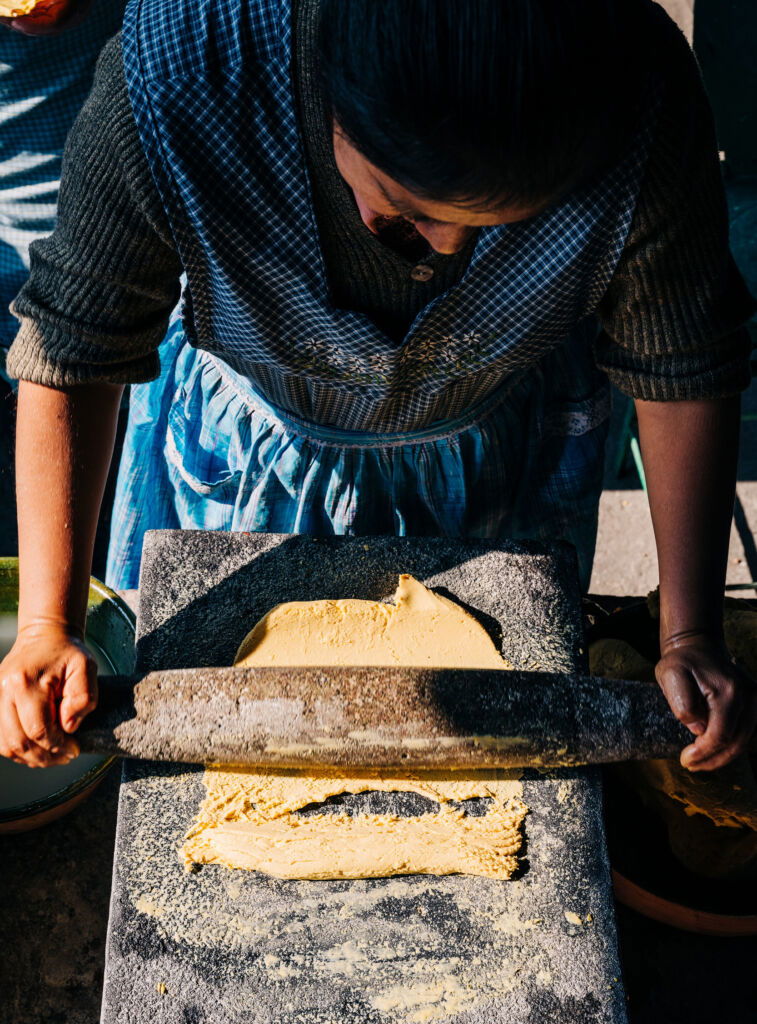
Ingredients That Define Oaxacan Cuisine
Walk through any traditional Oaxacan market, and witness a symphony of colors, textures, and aromas largely unchanged for centuries. The ingredients that define Oaxacan cuisine aren’t merely recipe components; they’re cultural artifacts, each carrying stories of indigenous wisdom, Spanish colonization, and unique geography shaping this extraordinary region.
The foundation of all Oaxacan cooking rests on ingredients considered sacred by pre-Columbian civilizations. These aren’t simply foodstuffs but building blocks of identity, woven so deeply into the cultural fabric that understanding Oaxacan ingredients means understanding its people’s souls.
- Corn: A sacred grain forming the foundation of tortillas, tamales, and atole, available in dozens of heirloom varieties with distinct flavors and colors
- Chiles: Including smoky pasilla de Oaxaca and complex chilhuacle negro essential for mole negro
- Chocolate: Essential for mole and traditional drinks like tejate, made from cacao beans cultivated here for over 2,000 years
- Beans: A staple protein in daily meals, with local varieties adapted to Oaxaca’s unique growing conditions
- Squash: Common in stews and sides, with both flesh and protein-rich seeds used extensively
- Tomatoes: Including familiar red varieties and indigenous tomatillos, adding acidity to countless sauces
- Herbs: Such as anise-scented hoja santa and pungent epazote, adding distinctive depth to traditional dishes
Each ingredient tells adaptation and survival stories. Take chocolate, for example. While the world knows cacao as the foundation for sweet confections, in Oaxaca, Mexico, it remains primarily savory, ground with almonds and cinnamon for complex mole base notes or whisked with corn masa for tejate, a refreshing pre-Columbian beverage still sold in markets today.
Oaxacan cheese deserves special mention, particularly famous quesillo or queso Oaxaca, a string cheese whose production methods were adapted from Dominican friars in the 16th century but refined through generations of local cheesemakers’ understanding how regional milk and climate affected final products.
A Spotlight on Ancient Corn Varieties and Chiles in Oaxacan Cooking
The relationship between Oaxacans and their corn transcends mere agriculture—it represents a sacred covenant between people and land that has sustained them for millennia. This reverence extends to other sacred plants like agave, where visitors can learn how mezcal is made using traditional methods passed through generations. In traditional Mexican markets, you can find corn in colors borrowed from artists’ palettes: deep purple, brilliant yellow, stark white, and kernels shimmering like obsidian.
Each heirloom corn variety brings unique flavor profiles and cultural significance. Purple corn, known locally as maíz morado, carries earthy, wine-like notes, enhancing atole morado, a traditional beverage served during Day of the Dead celebrations. White corn, prized for its subtle sweetness and fine texture, becomes the foundation for delicate tamales served at weddings and baptisms.
Ancient nixtamalization processes—treating dried corn with lime water to remove hulls and improve nutritional value—remain unchanged in many communities. This technique, developed by indigenous peoples thousands of years ago, not only makes corn more digestible but also creates distinctive flavor and aroma that defines authentic tortillas, tamales, and countless other staples.
Chiles in Oaxacan cuisine serve as both seasoning and character actors in culinary drama. Chilhuacle negro, with deep chocolate notes and mild heat, forms the mole negro backbone, while fiery chile de agua provides bright, clean heat essential to many salsas. Pasilla de Oaxaca, smoky and complex, bridges heat and flavor gaps irreplaceably in traditional recipes.
The Art of Oaxacan Cheese Making
In rolling hills surrounding Reyes Etla, thirty minutes north of Oaxaca City, morning mist carries cattle lowing and gentle milk splashing into metal pails. These sounds have been echoing across valleys since Dominican friars first introduced European dairy techniques to indigenous communities in the 1500s. Here, Oaxacan cheesemaking has evolved into an art honoring both Spanish traditions and local innovation.
Oaxacan cheese reflects the region’s unique geography and climate. Highland pastures, enriched by volcanic soil and kissed by consistent mountain breezes, produce milk with distinct mineral complexity apparent in finished cheese. Local cheesemakers understand these subtleties intimately, adjusting techniques based on seasonal variations in grass composition and weather patterns.
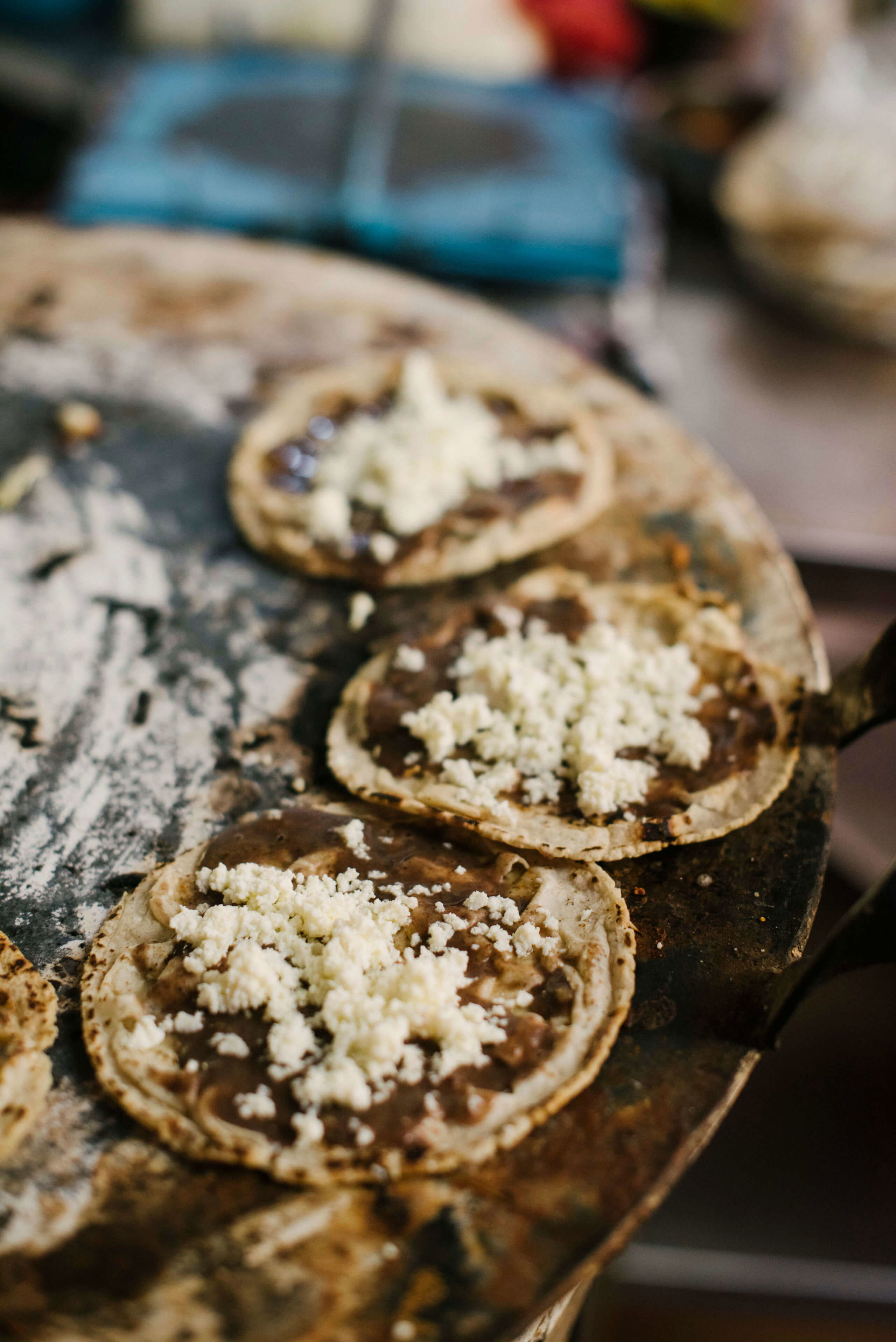
Quesillo: The String Cheese of Oaxaca
Imagine watching a master quesillero at work, witnessing a dance combining physics, artistry, and generations of inherited knowledge. The process begins before dawn, when fresh milk—still warm from cows—is carefully heated in massive copper cauldrons seasoned by decades of use.
Transformation from milk to quesillo requires precise timing and an intuitive feel. As milk reaches exactly the right temperature, cultures are added, and the cheesemaker waits for that magical moment when proteins begin coagulating. Too early, the texture becomes grainy; too late, the characteristic stretchiness defining quesillo disappears.
The most mesmerizing part comes when the curds are ready for stretching. A cheesemaker plunges weathered hands into hot whey, gathering curds into a smooth, elastic mass, then stretches and folds repeatedly until achieving a silky texture, making quesillo unique. The final product is wound into balls resembling white yarn, hence the name “string cheese.”
Fresh quesillo possesses a clean, slightly tangy flavor with hints of pasture grasses that fed cows. Its texture is simultaneously creamy and elastic, perfect for melting into quesadillas or stretching over hot tlayudas, creating Instagram-worthy cheese pulls that made Oaxacan street food famous worldwide.
Regional Cheese Variations
While traveling through Oaxaca’s diverse regions, you’ll discover that cheese making varies dramatically based on local traditions, altitude, and available resources. Coastal regions around Puerto Escondido incorporate sea salt harvested from evaporated tidal pools, creating cheeses with subtle briny complexity that pair beautifully with abundant seafood. Mountain communities of Sierra Juárez developed their own traditions, often aging products in natural caves where consistent temperature and humidity create ideal conditions for developing complex flavors. These mountain cheeses tend to be firmer and more aged, with nutty, crystalline textures reflecting the patience required by high-altitude living.
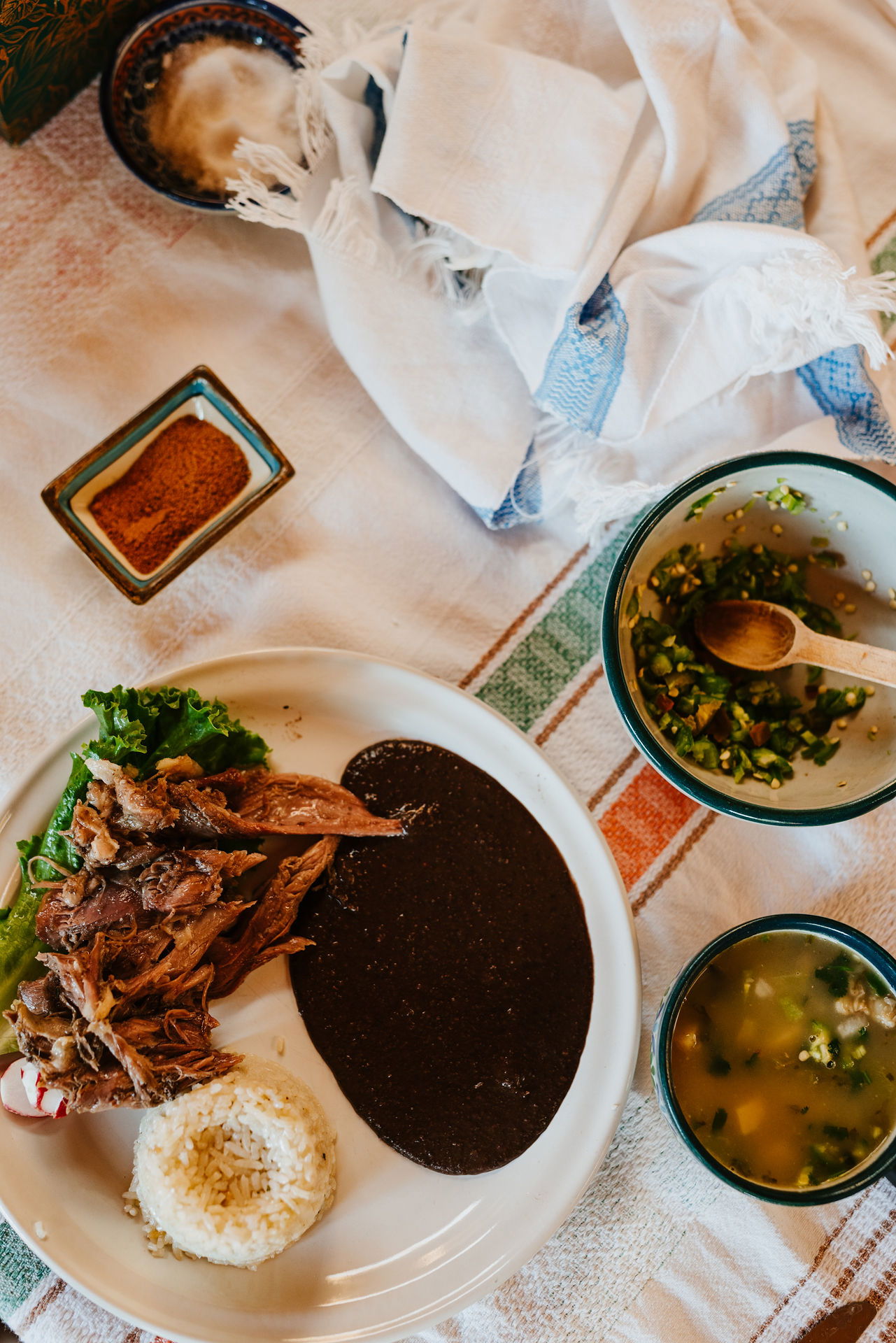
A Journey Through Oaxaca’s Seven Famous Mole Varieties
In Oaxaca, mole isn’t merely sauce—it’s philosophy, meditation on relationships between patience and flavor, tradition and innovation. Seven classical moles represent perhaps the most sophisticated expression of Mexican cuisine, each a complex symphony of ingredients, including anywhere from fifteen to over thirty individual components.
The cultural importance of mole extends far beyond the culinary realm. These sauces are central to Oaxacan identity, served at weddings, funerals, religious celebrations, and any gathering where community honors tradition. To prepare mole is to participate in an ancient ritual, connecting with ancestors who developed these recipes through centuries of experimentation and refinement.
- Mole Negro: King of moles, featuring over thirty ingredients including chocolate, multiple chile varieties, and a cooking process taking days to complete properly
- Mole Coloradito: Reddish-brown mole with a slightly sweet profile, traditionally served with chicken featuring ancho and guajillo chiles as primary components
- Mole Amarillo: Golden-yellow mole with a lighter, more herbaceous flavor profile, often served with beef or pork featuring yellow chiles and tomatillos
- Mole Verde: Fresh, vibrant green sauce made with herbs like hoja santa and cilantro, typically served with pork or chicken
- Mole Chichilo: Dark, smoky mole with almost black color, traditionally served with beef featuring distinctive burnt chile flavors
- Mole Manchamantel: Literally “tablecloth stainer,” this fruity mole includes pineapple and plantains, often served with pork
- Mole Rojo: Red mole with medium heat level, featuring tomatoes and red chiles, commonly served with turkey or chicken
Regional Mole Variations
Travel through Oaxaca’s eight regions, and discover that mole recipes vary not just town to town but family to family, each cook adding signature touches based on available ingredients, family traditions, and personal preference. In the Isthmus of Tehuantepec, moles incorporate more seafood-friendly profiles, with lighter, more acidic notes complementing the region’s abundant shrimp and fish. Mountain communities of Sierra Norte developed moles reflecting a cooler climate and different agricultural products. Here, you’ll find moles incorporating highland herbs and chiles that don’t grow in warmer valleys, creating distinctly different flavor profiles from lowland cousins.
The Art of Making the Iconic Mole Negro
Mole negro represents the pinnacle of Oaxacan culinary artistry, a sauce so complex and labor-intensive that many families reserve its preparation for the most important celebrations. The process begins days before serving, with careful selection and preparation of over thirty individual ingredients, each requiring specific treatment.
Chiles such as chilhuacle negro, mulato, ancho, chipotle, and pasilla must be cleaned, deseeded, and toasted individually to achieve precise smokiness and heat levels defining authentic mole negro. Too little toasting lacks depth; too much creates bitter notes, overwhelming complex flavor profiles.
The chocolate component isn’t the sweet confection most imagine but bitter cacao tablets ground with cinnamon and almonds, creating a base that adds richness without sweetness. Indigenous cooks understood that chocolate’s role wasn’t creating dessert but providing depth and body to sauce, like how dark beer might enhance stew.
Indigenous Cooking Methods That Shape Oaxacan Flavor
Flavors defining traditional Oaxacan food emerge not just from ingredients but from cooking methods developed over millennia by indigenous communities and understanding how different techniques coax unique flavors from the same basic components. These methods, passed down through generations, are learned by watching and tasting rather than reading recipes, and remain largely unchanged in many kitchens today.
Indigenous cooking approach emphasizes patience, an understanding of fire, and respect for ingredients. Unlike modern cooking, which often prioritizes speed and convenience, traditional techniques recognize the best flavors develop slowly, through careful heat, smoke, and time application. Here are some examples of traditional tools for these cooking methods:
- Comal: Flat, circular griddle traditionally made from clay, imparting subtle earthy flavor to tortillas, chiles, and vegetables during toasting
- Metate: Three-legged stone mortar and pestle carved from volcanic rock, essential for grinding corn, spices, and chiles into proper textures for authentic sauces
- Barbacoa Pit Ovens: Underground cooking chambers lined with hot stones and maguey leaves, used for slow-cooking meats until impossibly tender
- Ollas de Barro: Unglazed clay pots regulating temperature naturally and adding mineral notes to beans, stews, and moles during long, slow cooking processes
Cooking Tools and Techniques
The Comal represents perhaps the most essential tool in any Oaxacan kitchen. Its clay surface is seasoned by years of use, developing a natural non-stick patina that can’t be replicated by modern materials. The best comales are made from clay mixed with ground pottery shards, creating a surface that distributes heat evenly while adding subtle mineral notes to anything cooked on it.
A Metate, carved from a single piece of vesicular basalt, represents one of humanity’s oldest food processing tools. Porous volcanic stone creates friction, releasing oils and flavors from spices and chiles in ways steel blades simply cannot match. A well-seasoned metate, passed down through generations, becomes increasingly effective over time as the stone surface develops a perfect grinding texture.
Barbacoa pit ovens transform tough cuts of meat into succulent, fall-apart tender dishes through a combination of moist heat, smoke, and time that no modern oven can replicate. The underground chamber, lined with hot coals and covered with aromatic maguey leaves, creates a natural steam environment that breaks down collagen slowly while infusing meat with earthy, vegetal flavors from the agave. This ancient technique produces textures impossible to achieve through conventional cooking—meat so tender it separates at the touch of a fork, saturated with smoky essences that penetrate to the bone.
Ollas de barro regulate temperature through their porous clay walls, which allow gradual evaporation that concentrates flavors while preventing the harsh boiling that metal pots create. These unglazed vessels breathe with the cooking process, their mineral-rich clay adding subtle earthy notes to beans and stews while maintaining gentle, consistent heat that develops complex flavors over hours of slow simmering. The clay’s natural alkalinity also affects the cooking chemistry, helping beans maintain their shape while becoming creamy inside, and allowing mole ingredients to meld in ways that create the velvety textures prized in authentic preparations.
From Street Food to Sacred Dishes
The genius of Oaxacan cuisine lies in the seamless integration of the everyday and sacred, where the same ingredients fueling daily life also serve as offerings to ancestors and community celebrations. Street food in Oaxaca represents edible folklore, with each vendor carrying forward recipes and techniques connecting directly to pre-Columbian traditions.
Walk through the streets surrounding central markets in the early morning, and encounter food vendors whose setups would be instantly recognizable to ancestors from centuries past. Clay comales rest over wood fires, sending aromatic smoke signals across plazas while vendors prepare tlayudas with the same hand movements their grandmothers used.
The relationship between street food and sacred dishes in Oaxacan culture isn’t hierarchical but circular. Tamales sold by street vendors use the same masa preparation techniques employed for ceremonial tamales offered to the dead during Día de los Muertos. Mole served at roadside stands might be a simplified version of complex sauces prepared for weddings, but it maintains the same essential flavor principles and cultural significance.
When someone enjoys Oaxaca street food from market stalls, they’re participating in the same culinary traditions sustaining communities for millennia.
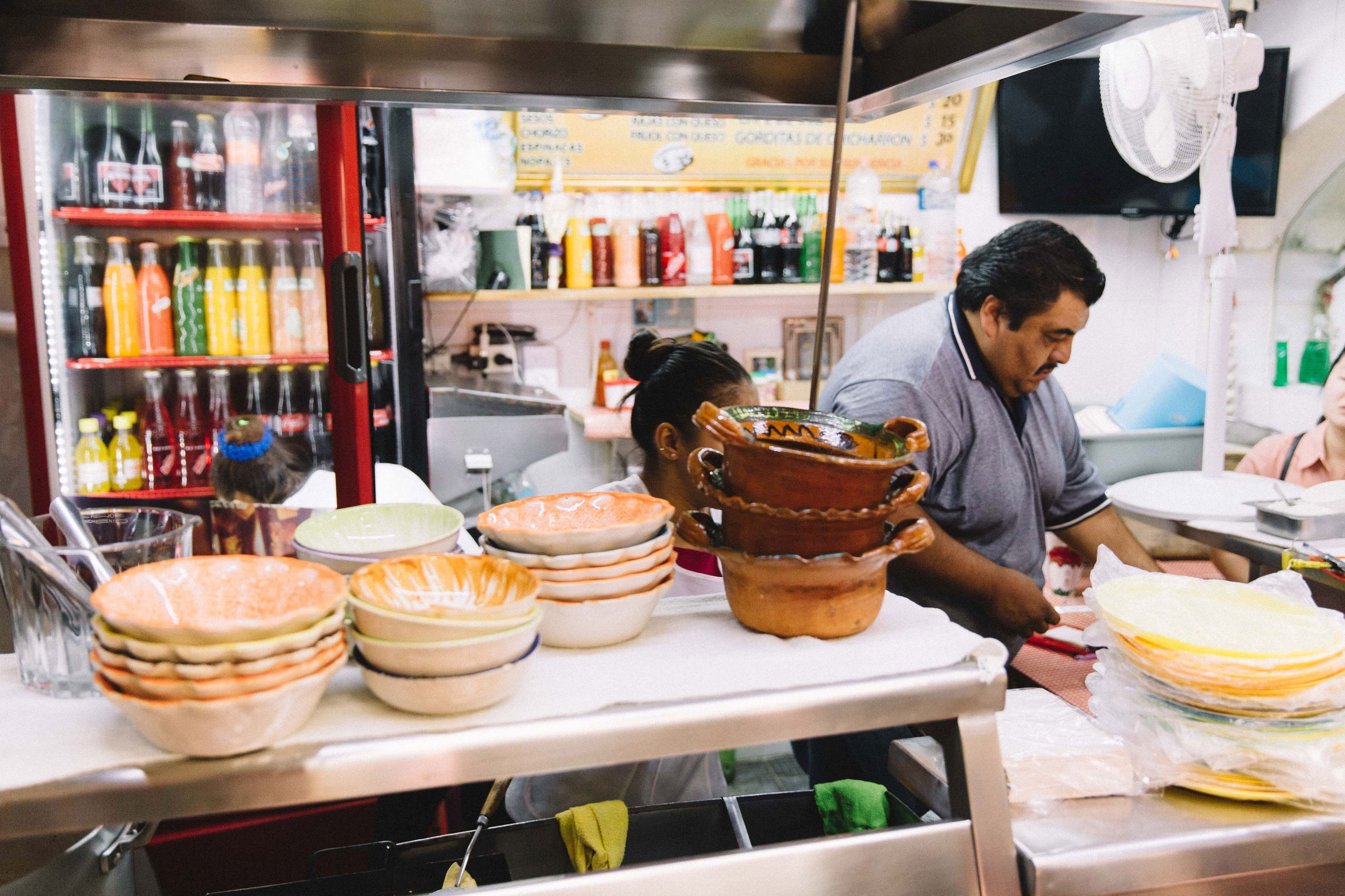
Modern Interpretations of Traditional Dishes
Contemporary Oaxacan chefs walk delicate lines between innovation and tradition, seeking ways to honor ancestral recipes while adapting to modern ingredients, techniques, and dietary preferences. Most successful modern interpretations don’t abandon traditional methods but use them as foundations for creative expression.
Take tlayudas for example—massive, crispy tortillas serving as edible plates for beans, cheese, meat, and salsa. Modern interpretations might incorporate non-traditional proteins like duck or fish, but the essential technique remains unchanged: a tortilla made from nixtamalized corn is cooked on a clay comal until crispy but flexible and then topped with ingredients balancing creamy, spicy, and acidic elements.
Tamales offer perhaps the most creative canvas for modern interpretation while maintaining traditional foundations. Contemporary versions might feature fillings like mushrooms with epazote or cheese with huitlacoche, but still require the same masa preparation, banana leaf wrapping, and steam cooking that indigenous communities developed centuries ago.
Education and Community Efforts
Throughout Oaxaca, cooking schools, community centers, and cultural organizations work to ensure traditional food knowledge passes to new generations. These efforts recognize that preserving Oaxacan food culture requires more than documenting recipes—it demands maintaining living traditions of ingredient selection, seasonal cooking, and community food preparation.
Community kitchens in many villages serve as informal academies where older women teach younger family members intricate techniques required for mole preparation, tamale making, and cheese production. These sessions often accompany major celebrations, turning food preparation into social events, and strengthening community bonds while preserving cultural knowledge.

The Role of Food in Oaxacan Rituals and Celebrations
Food in Oaxacan culture serves as a bridge between physical and spiritual worlds, a medium through which communities communicate with ancestors, celebrate milestones, and reinforce social bonds. Every significant life event—from birth to death, harvest to marriage—involves specific foods prepared in traditional ways, carrying meanings far beyond mere nutrition.
Day of the Dead Offerings
During Día de los Muertos, Oaxacan families create elaborate altars adorned with foods beloved by deceased relatives, believing souls return during this time to enjoy the essence of favorite dishes. Preparation becomes an act of remembrance and love, with families often spending days preparing complex moles, tamales, and sweets, demonstrating continuing devotion to lost loved ones.
Pan de muerto, sweet bread traditionally baked for Day of the Dead, holds special significance in Oaxacan celebrations. Local bakers create versions decorated with bone-shaped dough pieces and dusted with sugar, representing memory’s sweetness. Each family has preferred shapes and flavors—some incorporate orange zest and anise, others add chocolate or fruit—but all share a common purpose of honoring those who passed.
Mole holds particular importance in Day of the Dead celebrations, with many families preparing the most complex and cherished recipes specifically for altar offerings. Labor-intensive preparation becomes meditation and devotion forms, with multiple generations working together to toast chiles, grind spices, and slowly simmer sauce to perfection.
Wedding and Festival Dishes
Oaxacan weddings feature elaborate food presentations demonstrating a family’s respect for guests and commitment to maintaining cultural traditions. Preparation often begins weeks in advance, with extended families contributing different dishes and techniques, creating feasts and feeding hundreds while showcasing a full range of regional specialties.
Estofado, a complex stew featuring tender meat in rich, spiced sauce, represents one of the most prestigious dishes served at Oaxacan weddings. Preparation requires days of advance work, with families carefully selecting and preparing spices, creating homemade vinegar, and slow-cooking meat until achieving the proper texture and flavor.
Tamales de frijol, stuffed with seasoned beans and wrapped in banana leaves, serve as vegetarian options honoring indigenous traditions while accommodating diverse dietary needs. These tamales require particular skill to prepare properly—masa must be beaten to correct lightness, beans must be seasoned and cooked to perfect consistency, and banana leaves must be prepared to impart subtle flavor without overwhelming the filling.
How Do Markets Shape Food Culture in Oaxaca?
Markets of Oaxaca function as living museums of culinary culture, spaces where ancient traditions intersect with contemporary needs and where daily food procurement rhythm maintains connections to agricultural cycles sustaining communities for millennia. These aren’t simply places to buy ingredients—they’re social institutions preserving knowledge, fostering relationships, and ensuring the continuation of traditional food culture.
Market vendors often represent multiple generations of specialized knowledge, with families maintaining stalls focusing on specific products or preparations passed down through decades of experience. Elderly women selling chiles can identify dozens of varieties by sight, explain heat levels and flavor profiles, and recommend specific uses based on customers’ intended dishes.
Notable Market Tours
Central de Abastos, sprawling across several city blocks, represents one of Mexico’s largest and most diverse markets, where vendors from across Oaxaca’s eight regions bring specialized products to trade and sell. Walking through maze-like corridors reveals the incredible biodiversity of Oaxacan cuisine—dozens of chile varieties, multiple types of beans and corn, exotic fruits, traditional sweets, and prepared foods demonstrating the full range of regional cooking styles.
Mercado 20 de Noviembre, known locally as “mercado de comida,” specializes in prepared foods and offers visitors chances to experience authentic Oaxacan dishes in their most traditional contexts. Here, multiple generations of the same families operate small restaurants serving moles, tlayudas, and tamales prepared using recipes and techniques passed down through decades of market cooking.
The Saturday market in Tlacolula, about thirty minutes from Oaxaca City, attracts vendors from throughout the Central Valleys, creating weekly celebrations of regional diversity. This market maintains a more traditional atmosphere, with vendors displaying products on woven petates and customers engaging in social interaction, transforming shopping into community building.
Seasonal Ingredients and Market Culture
Seasonal availability of ingredients in Oaxacan markets reflects both natural agricultural cycles and traditional preservation methods developed to ensure year-round nutrition. During corn harvest season, markets overflow with fresh elotes, esquites, and fresh masa for tamales, while vendors simultaneously prepare dried corn for nixtamalization during leaner months.
Chile seasons bring dramatic changes to market offerings, with different varieties ripening at different times throughout the year. Fresh chiles de agua appear during summer rains, while dried chiles provide heat and flavor during cooler months. Market vendors understand these cycles intimately, often advising customers on which chiles work best for specific dishes during different seasons.
Market culture also preserves traditional food preparation techniques through daily practice. Watching vendors prepare fresh tortillas on clay comales, grind chiles on volcanic stone metates, or wrap tamales in banana leaves provides a living demonstration of techniques connecting directly to indigenous traditions.
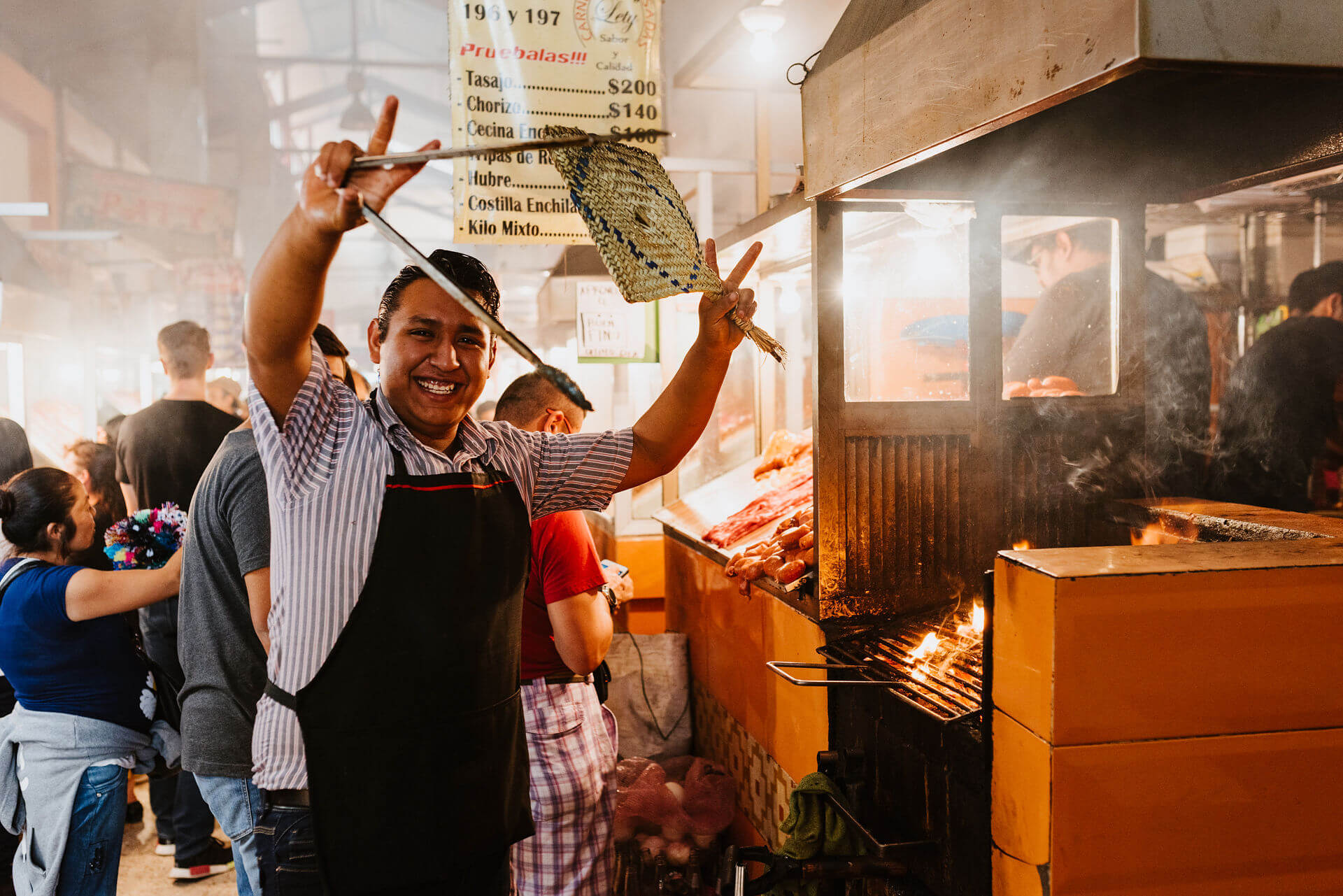
The Enduring Spirit of Oaxaca Through Its Food
As afternoon sun slants through arches of Oaxaca’s colonial buildings, casting golden light across market stalls where vendors pack up wares for another day, the enduring spirit of this remarkable cuisine reveals itself not in any single dish but in countless daily acts of preparation, sharing, and preservation, keeping ancient traditions vibrantly alive.
Traditional food from Oaxaca represents far more than collections of recipes or techniques—it embodies worldviews that see eating as sacred acts, cooking as cultural transmission forms, and sharing food as fundamental community building blocks. In every tlayuda spread with beans and cheese, in every complex mole requiring days of preparation, in every simple tortilla pressed by hand and cooked on a clay comal, values and wisdom of countless generations find expression.
The resilience of Oaxacan food culture in the face of globalization and modernization demonstrates a tradition’s power when remaining adaptive rather than frozen in time. Contemporary Oaxacan cooks honor their ancestors not by rejecting all change but by understanding which elements represent essential spirits of their cuisine and which can evolve to meet contemporary needs and tastes.
Whether rooted in ancient tradition or modern reinterpretation, authentic Oaxacan cuisine continues to reflect remarkable creativity that emerges when communities maintain deep connections to their land, ingredients, and cultural inheritance. Seven moles crowning Oaxacan cuisine, dozens of chile varieties providing heat and flavor, indigenous cooking techniques coaxing maximum flavor from simple ingredients—all represent solutions developed by people understanding that good food requires patience, respect, and love.
Today, as travelers from around the world discover the sophistication and complexity of traditional Oaxacan food through Mexico luxury travel destinations, they encounter not just delicious dishes but complete philosophies of living, seeing food as central to identity, community, and spiritual connection. Growing international appreciation for Oaxacan cuisine ensures these traditions will continue evolving and adapting while maintaining essential character.
The true victory of Oaxacan food culture lies not in preservation unchanged but in continued vitality through young cooks learning to grind corn on metates while mastering modern techniques, in families gathering for traditional celebrations while welcoming new traditions, and in communities sharing culinary heritage with visitors while maintaining an authentic spirit.
Through every dish—whether prepared in village kitchens using techniques unchanged for centuries or adapted in contemporary restaurants honoring traditional flavors while embracing innovation—Oaxaca’s cultural spirit lives on, nourishing bodies and souls while connecting past, present, and future in unbroken chains of taste, tradition, and community. In this way, traditional Oaxacan food becomes not just cuisine but cultural DNA forms, carrying essential information needed to maintain identity and connection across generations.
Flavors of Oaxaca—smoky, complex, deeply rooted in indigenous wisdom yet open to thoughtful evolution—continue influencing food lovers around the world, inspiring chefs, home cooks, and travelers who recognize great cuisine emerges not from novelty but from patient cultivation of tradition, technique, and taste. As long as there are hands willing to grind corn on volcanic stone, patient enough to tend complex moles, and communities committed to sharing culinary heritage, the spirit of Oaxaca will continue nourishing the world, one perfectly crafted dish at a time.

Oaxaca Tour with Nixtaco

Oaxaca Tour with Steven Molnar

Oaxaca Tour with Christian Irabién

Oaxaca Tour with Sara Bradley

